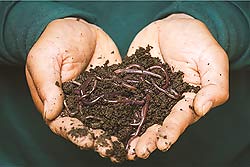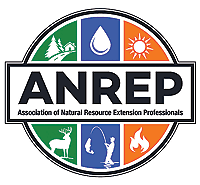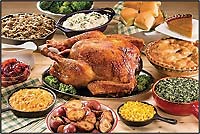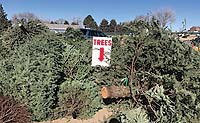 Do you feel a sense of guilt when throwing your apple cores away, or wonder how you can help reduce the 40% of our food supply that is wasted in the United States? A storage tote and handful of red wiggler worms may help! Do you feel a sense of guilt when throwing your apple cores away, or wonder how you can help reduce the 40% of our food supply that is wasted in the United States? A storage tote and handful of red wiggler worms may help!
 To create your own household vermicompost system, the first thing you will need is a bin with a lid. You can get creative here: old storage totes, buckets, garbage bins, etc. If you don’t have one lying around, search our local thrift stores. Once you have your bin, you will need to drill or punch holes around the top of the bin and the lid. Next, you will need bedding material such as shredded newspaper scraps or office paper as well as a handful of grit (worms grind down food in their gizzards and this requires grit): Coffee grinds or sand are great for this. Then, add enough water that your system has the moisture-level of a freshly wrung-out sponge. Lastly, add food scraps (ideal to push below bedding to ensure no “off” smells from your system), and WORMS! Not all worms are created equal and red worms are the kind you want for your compost system, as opposed to earth worms (which do not process as much organic waste each To create your own household vermicompost system, the first thing you will need is a bin with a lid. You can get creative here: old storage totes, buckets, garbage bins, etc. If you don’t have one lying around, search our local thrift stores. Once you have your bin, you will need to drill or punch holes around the top of the bin and the lid. Next, you will need bedding material such as shredded newspaper scraps or office paper as well as a handful of grit (worms grind down food in their gizzards and this requires grit): Coffee grinds or sand are great for this. Then, add enough water that your system has the moisture-level of a freshly wrung-out sponge. Lastly, add food scraps (ideal to push below bedding to ensure no “off” smells from your system), and WORMS! Not all worms are created equal and red worms are the kind you want for your compost system, as opposed to earth worms (which do not process as much organic waste each  day, do not thrive well in confinement, or deal well with disturbance). You can put a call out for red wigglers on any of our local foodies/gardener groups and can likely get them for free. If your bin starts to smell “off” and/or your worms try to escape (by wiggling up the sides of your bin in large numbers), your system is (going) anaerobic. You will either need to fix your moisture level, ensure there is enough bedding and/or grit, the room temperature is right (ideally between 55 and 77 degrees, and/or you need to “fluff” your bin to aerate it. Yes, that’s pretty much it! Easy, right? day, do not thrive well in confinement, or deal well with disturbance). You can put a call out for red wigglers on any of our local foodies/gardener groups and can likely get them for free. If your bin starts to smell “off” and/or your worms try to escape (by wiggling up the sides of your bin in large numbers), your system is (going) anaerobic. You will either need to fix your moisture level, ensure there is enough bedding and/or grit, the room temperature is right (ideally between 55 and 77 degrees, and/or you need to “fluff” your bin to aerate it. Yes, that’s pretty much it! Easy, right?
If you need more convincing, here are some additional reasons why you may want to start a vermicomposting (worm composting) system; vermicompost:
• Contains more nitrogen, phosphorus, and potassium than farmyard manure.
• Contains more manganese, copper, zinc, iron, and same amount of magnesium than farmyard manure minerals
• Can be used a powerful soil amendment for indoor and outdoor plants
• Acts as a disease suppression
• Balances pH
• Increases moisture and nutrient retention in your soil
• Applied to soil, lessens crusting and other physical damages common to soils in arid climate
• Can work indoors year-round
• Is convenient, compact, and neat
• Teaches kids and adults about small-scale ecosystems and decomposition
• Produces an abundance of fishing worms |
 Discover more in our fact sheet by searching “USU Extension: Vermicomposting” Discover more in our fact sheet by searching “USU Extension: Vermicomposting”
or by searching YouTube for USU Extension Worm Bin Composting.
Happy composting,
Roslynn Brain McCann & Kate Weigel
USU Extension Sustainability
|
Although the holidays look a little different this year with smaller gatherings, reduced travel, and several more visits from neighborhood delivery trucks, we can still do our part to make environmentally responsible choices and foster sustainable holiday traditions for years to come. This can be accomplished in a variety of ways and at several levels, specifically in regard to food waste reduction, alternative gift-giving ideas, and what to do once the festivities have ended. Sustainability is typically not considered during the whirlwind of Thanksgiving feasts, Christmas exchanges, and News Years’ celebrations but, with just a little planning and imagination, you can gift our planet with a little extra effort. Below are some suggestions of how to achieve a greener holiday season:
A Well-Planned Feast for All
 |
| photo credit: Zorn’s of Bethpage |
Golden turkey, mountains of mashed potatoes, and Grandma’s secret pecan pie recipe are staples of the holiday season. Excess is king, but according to the Director of Food Waste of the World Wildlife Fund, “by throwing away extra food, we are also throwing away the land, water, and energy used to produce that food.” The following actions can assist in reducing food waste:
• Plan your meals out carefully and shop smart by selecting the proper quantities and items that have several uses.
If choosing to gather for holiday meals, have visible and accessible recycling (and if applicable, compost) bins available to your guests.
• Encourage friends and family to bring containers for leftovers.
• Freeze remaining food for an extra meal or two later or research creative recipes to incorporate leftovers into new ideas.
Donate any extra food (such as unused cans of food) to local food banks such as the Grand County Food Bank or religious entities such as the Episcopal Church of St. Francis.
Light the Way (In an Energy Smart Manner)
We all love the twinkling of holiday lights, but you can still deck the halls with these energy efficient tips:
Switch to LED Christmas lights – they use 90% less electricity than regular Christmas lights. Fiber optic decorations are also available.
• Use a timer to avoid leaving lights on for too long or during the day.
• Use alternative lighting such as candles, especially rechargeable battery powered candles, to create that coveted holiday glow.
• Forego the use of traditional holiday lights completely and utilize natural decorations instead such as wreaths, garlands, and uniquely crafted reuse pieces.
The Joy of Green Gift-Giving
 |
| photo credit: makeitgrateful.com |
Gifts are one of the easiest ways to be environmentally conscious and budget friendly. A bit of research can provide many clever ideas for creating, selecting, wrapping, and packaging gifts for your friends and loved ones this holiday season.
• Seek out gifts that have minimal packaging or are sourced from verified eco-friendly manufacturers.
• Shop local at locations such as Moab Made, Back of Beyond Book Store, and Desert Thread. Purchasing from local businesses supports the local economy and artists while reducing carbon footprint.
• Consider eco-friendly gifts that can be used up (soaps and candles), made of recycled material, environmentally focused (seeds, plants, and gardening tools), or handmade (baked goods, a chore coupon book, or a trip to your local museum).
• Avoid non-recyclable wrapping paper and packing material such as Styrofoam and plastic bags. Wrapping paper beyond newspaper or butcher paper is typically not recyclable, especially if the paper is metallic or covered in glitter. Avoid the use of plastic bows and ribbon – those are not recyclable either and usually end up in your local landfill.
• If shopping online is necessary, try to combine orders by placing as few orders as possible to reduce overall transportation use.
After the Decorations Come Down
Once the festivities are over, it’s time to pack away the lights and take a breath after the chaos of cooking and holiday celebrations. Be wise with how you handle your post-holiday sustainability by considering the following:
• Avoid wish-cycling. Wish-cycling is the process of putting non-recyclable items in the recycling bin with the hope they will be recycled. Research what your local recycling centers do and do not accept. Non-recyclable items always end up in the trash.
 |
| photo credit: Albuquerque Journal |
• Compost or recycle your tree. Trees, free of decorations and lights, can be recycled either through means of composting, reused as mulching material, or if the roots are kept intact, replanted. If a live tree is not possible, be conscientious when purchasing an artificial tree.
• Out with the old electronics and directly into the electronic waste recycling bin. Electronics see a high turnover during the Christmas month and old electronics can either be donated to places like WabiSabi or recycled locally at the Community Recycle Center.
There are a variety of ways that sustainability can be accomplished during the holiday season. From food waste to the storage of that inflatable snowman you bought two years ago on a whim, we can all do our part to minimize our impact and follow the mantra of reduce, reuse, and recycle. The season of giving can extend beyond those few months and provide a positive impact in our communities for future generations to come.
|
 Do you feel a sense of guilt when throwing your apple cores away, or wonder how you can help reduce the 40% of our food supply that is wasted in the United States? A storage tote and handful of red wiggler worms may help!
Do you feel a sense of guilt when throwing your apple cores away, or wonder how you can help reduce the 40% of our food supply that is wasted in the United States? A storage tote and handful of red wiggler worms may help! To create your own household vermicompost system, the first thing you will need is a bin with a lid. You can get creative here: old storage totes, buckets, garbage bins, etc. If you don’t have one lying around, search our local thrift stores. Once you have your bin, you will need to drill or punch holes around the top of the bin and the lid. Next, you will need bedding material such as shredded newspaper scraps or office paper as well as a handful of grit (worms grind down food in their gizzards and this requires grit): Coffee grinds or sand are great for this. Then, add enough water that your system has the moisture-level of a freshly wrung-out sponge. Lastly, add food scraps (ideal to push below bedding to ensure no “off” smells from your system), and WORMS! Not all worms are created equal and red worms are the kind you want for your compost system, as opposed to earth worms (which do not process as much organic waste each
To create your own household vermicompost system, the first thing you will need is a bin with a lid. You can get creative here: old storage totes, buckets, garbage bins, etc. If you don’t have one lying around, search our local thrift stores. Once you have your bin, you will need to drill or punch holes around the top of the bin and the lid. Next, you will need bedding material such as shredded newspaper scraps or office paper as well as a handful of grit (worms grind down food in their gizzards and this requires grit): Coffee grinds or sand are great for this. Then, add enough water that your system has the moisture-level of a freshly wrung-out sponge. Lastly, add food scraps (ideal to push below bedding to ensure no “off” smells from your system), and WORMS! Not all worms are created equal and red worms are the kind you want for your compost system, as opposed to earth worms (which do not process as much organic waste each  day, do not thrive well in confinement, or deal well with disturbance). You can put a call out for red wigglers on any of our local foodies/gardener groups and can likely get them for free. If your bin starts to smell “off” and/or your worms try to escape (by wiggling up the sides of your bin in large numbers), your system is (going) anaerobic. You will either need to fix your moisture level, ensure there is enough bedding and/or grit, the room temperature is right (ideally between 55 and 77 degrees, and/or you need to “fluff” your bin to aerate it. Yes, that’s pretty much it! Easy, right?
day, do not thrive well in confinement, or deal well with disturbance). You can put a call out for red wigglers on any of our local foodies/gardener groups and can likely get them for free. If your bin starts to smell “off” and/or your worms try to escape (by wiggling up the sides of your bin in large numbers), your system is (going) anaerobic. You will either need to fix your moisture level, ensure there is enough bedding and/or grit, the room temperature is right (ideally between 55 and 77 degrees, and/or you need to “fluff” your bin to aerate it. Yes, that’s pretty much it! Easy, right? Discover more in our fact sheet by searching “USU Extension: Vermicomposting”
Discover more in our fact sheet by searching “USU Extension: Vermicomposting” 

